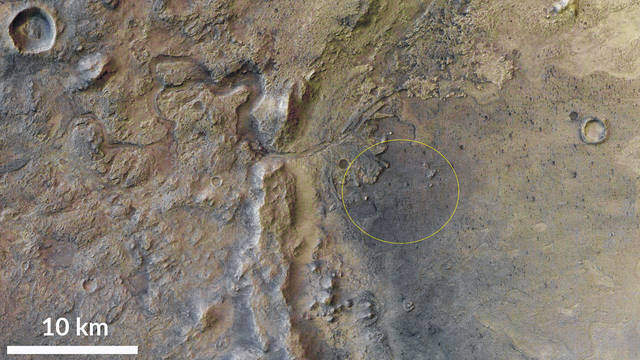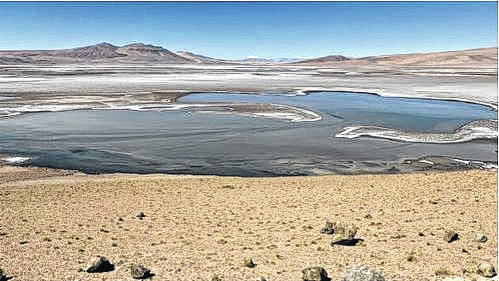
Shown is the Jezero crater on Mars, with the landing site of Perseverance circled in yellow. Perseverance is scheduled to land on Mars on Feb. 18.
Courtesy photo
When you think of Mars, what comes into your mind? Martians, armed with ray guns coming to earth with ill intent? A barren, dry, and cold wasteland? A watery wonderland of rivers, lakes, seas and rain?
With the exception of the armed martians, you are correct. The question is, when are we talking about? Mars today is desolate, dry and cold. Bathed in radiation, its surface is sterile.
Over the past 58 years of orbital and surface explorations, however, NASA has uncovered a treasure trove of watery history. Four billion years ago, Mars was much warmer and wetter, with a thick atmosphere — thick enough to hold down liquid water on its surface.
Perseverance lands on Mars in five days. It’s landing ellipse is centered on the floor of Jezero Crater, 31 miles in diameter, and mostly flat. After the impact crater was created, water filled the basin, courtesy of a river that flowed into the crater. Water also flowed out the other side of the crater. The lake was there for a long time, probably many millions of years. We know this because the river dumped its load of sediment into a delta, in places hundreds of feet tall. A geological feature like that requires millions of years to form, and is testament to the long duration of liquid water on Mars.
The big question that Perseverance will try to answer: Was water there long enough for life to evolve? Perseverance is looking for fossils, in the same way we might look for fossils along the banks of the Lumber River. Perseverance seeks biosignatures in the rocks. A biosignature is a trace fossil of alteration of the rock that can only occur when it records an interaction with a living thing. Of course finding shells or bones would be ideal, however, that is unlikely. Microorganisms are much more likely, and they too leave telltale hints in the rocks.
This is what Perseverance is looking for.
Perseverance, in addition to studying the rocks with its suite of instruments, cameras and spectrometers, will also be taking sample tubes of martian soil and rock, leaving them in its wake for a future sample return mission to hoist back to Earth. There, the samples can be examined with the finest equipment available here that you just can’t pack onto a car-sized robot going to Mars.
Additionally, there are 23 cameras and two microphones that will enhance the landing and exploration of Mars. These cameras and microphones will also provide a first-ever landing experience, seeing and hearing the landing as it unfolds five days from now.
Perseverance joins an impressive fleet of Mars exploration vehicles, both orbiters and surface vehicles. Last week, both China and the United Arab Emirates joined the Mars exploration club, successfully inserting their spacecraft into orbit around Mars. In May, China will be deploying a lander and rover combo onto Mars’ surface. Hopefully, that will add China to the extremely exclusive roster (so far, the USA is the only member) of nations that have successfully landed on Mars.
But what if the mission fails? As regards Mars exploration, all is not lost. Curiosity has been quietly going about its business on Mars, driving over 15 miles in 8.5 years and counting. It continues to explore, and will do so whether or not Perseverance survives.
Thursday, beginning at noon, the NC Museum of Natural Sciences, the Robeson Planetarium, NASA TV, and the Jet Propulsion Lab will be doing a joint live presentation that culminates in the landing of Perseverance on Mars. To register and attend some or all of this historic event, go to https://naturalsciences.org/calendar/event/perseverance-landing-event/ and sign up.
See you on the plains of Mars!
Ken Brandt is the director of the Robeson Inflatable Planetarium. The planetarium remains at the Robeson County Partnership for Children in downtown Lumberton while awaiting a rebuild after the flooding caused by hurricanes Matthew and Florence. If you are interested in helping the rebuilding effort, email Ken at [email protected]. For more information about the Robeson Planetarium and Science Center visit www.robeson.k12.nc.us/domain/47










